December 31, 1999: It’s a balmy end to the 2nd millennium over Minnesota, with temperatures in the 30s over central and southern Minnesota near midnight.
December 31, 1937: Damage is done by a flood at Grand Marais, while 18 inches of snow is dumped on Grand Portage.
December 31, 1913: New Ulm has its fortieth consecutive day without precipitation.

The Gift of Time – And an Early January Thaw
The older I get the more I realize the ultimate gift is time. My Christmas list shrinks every holiday as it dawns on me that what I want most can’t be purchased. Time with family & friends. Time to do the things I enjoy.
Another gadget? A hollow thrill that quickly fades. “It’s really clear that the most precious resource we all have is time” said the late Steve Jobs. The world may measure success with the metrics of money and consumption, but they aren’t the most treasured currency.
The last day of 2015 brings teens with a wind chill in single digits. You remember how to shiver, right?
Metro temperatures may thaw to near 32F over the weekend as another puff of Pacific air arrives – from the northwest of all places. No more headline-leading storms brewing; we start 2016 on a quiet, seasonably cool note.
On the weather blog below: the top Minnesota weather stories of 2015, historic flooding in the UK, the warmest December on record for Germany and 30s (above zero) at the North Pole? That’s 50-600F warmer than average for late December.
I suspect this may be more than just El Nino.


Heat Wave at the North Pole? 30s and 40s (above zero) at the top of the world in late December is beyond freakish, explains meteorologist Eric Holthaus at Slate. Factor in EF-4 tornadoes and 10 foot snow drifts in Texas in late December, amazingly persistent warmth with flowers in bloom out east, record flooding in Missouri helping to shut down parts of the Mississippi River, along with record flooding in the UK and South America and you have the makings of a much broader trend. Here’s an excerpt: “…The remarkable storm will briefly boost temperatures in the Arctic basin to nearly 10 degrees Fahrenheit warmer than normal—and the North Pole itself will be pushed above the freezing point, with temperatures perhaps as warm as 40 degrees. That’s absolutely terrifying and incredibly rare. Keep in mind: It’s late December and dark 24 hours a day at the North Pole right now. The typical average high temperature this time of year at the North Pole is about minus 15 to minus 20 degrees. To create temperatures warm enough to melt ice to exist in the dead of winter—some 50 or 60 degrees warmer than normal—is unthinkable...On Wednesday, the North Pole will be warmer than Western Texas, Southern California, and parts of the Sahara.”
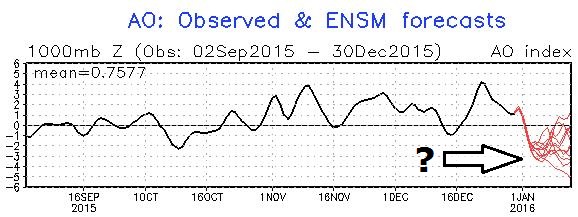
All signs point to the El Niño pattern continuing to dominate the end of December with the potential for delivering some rain or snow to drought-stricken California and a high probability of a warmer than normal Christmas in the U.S. northeast.However, there may be a need to keep those winter coats in the front of the closet. Some scientific indicators suggest a January 2016 weakening of the stratospheric polar vortex, increasing the chance for severe late winter weather over the continents…”

Warmest December in Germany on Record. How’s your German? Mine is rusty, but I was able to make out the headlines at Suddeutsche Zeitung. (December temperature anomalies across Europe and Asia are running 10-15F warmer than average; map courtesy of WeatherBell).

Death Toll Rises in Missouri Floods, Threat Not Over. Historic December rains falling on partially frozen ground and running off into tributaries has tipped the Mississippi River to flood stages not seen since 1993. Here’s an excerpt from NBC News: “… (Governor) Nixon declared a state of emergency on Monday and activated the National Guard on Tuesday. He pledged help for inundated towns. President Barack Obama called Nixon for a briefing on the situation Wednesday, and directed his staff to coordinate with the state on any federal assistance required, the White House said. “We are here before the water rises, we’re here after it falls,” Nixon said. “We’re here until this place is back to where it was before. And sometimes that takes a while.” Parts of the Meramec River were between two and three feet higher than during a devastating flood in 1993, which is also known as the “great flood,” Nixon said. The Mississippi River at Thebes, Illinois, reached two feet higher than in 1993, he said…”
Photo credit above: “In this aerial photo, the Mississippi River flows out of its banks Wednesday, Dec. 30, 2015, near West Alton, Mo. A rare winter flood threatened nearly two dozen federal levees in Missouri and Illinois on Wednesday as rivers rose, prompting evacuations in several places.” (AP Photo/Jeff Roberson)

Worst Flooding in St. Louis Area in More Than 20 Years. Interstate 44 is still shut down because of flood waters; here’s an excerpt of a comprehensive update at St. Louis Post-Dispatch: “The St. Louis region is grappling with the most extensive flooding seen in more than 20 years. Record rainfall over the weekend and Monday have ended, but area rivers keep rising…”
Photo credit above: “Water swells on Highway 141 underneath a closed Interstate 44 overpass on Wednesday, Dec. 30, 2015.” Photo by Robert Cohen.
* U.S. Army Corp of Engineer flood-fighters are now fully engaged. Details here.

More April than December. Check out the precipitation anomaly map for December, to date, showing 4 times more rain than average across a huge swath of territory from Wisconsin into central Iowa and eastern Nebraska; another soggy bulls-eye from Tulsa to St. Louis. It’s unusual to see such a large area over the USA east of the Rockies so wet in December; a function of El Nino and a warmer atmosphere able to hold more water vapor. Source: PRISM Climate Group, Oregon State University.
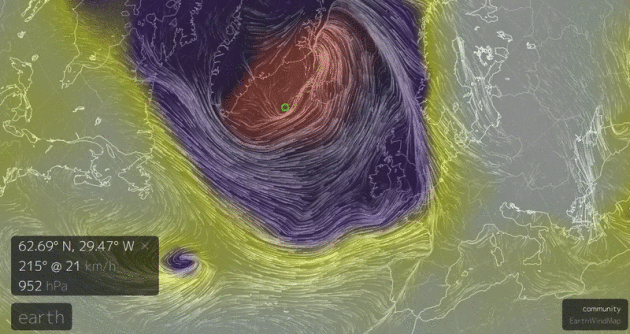
Historic Storm Set to Slam Iceland, Northern UK with Hurricane-Force Winds. Andrew Freedman at Mashable has a good overview of a wild storm bringing the prospect of more wind, wave and flood damage – and record warmth for the North Pole; here’s the intro: “One of the strongest storms on record to form in the North Atlantic is set to rock Iceland with winds above hurricane force by Wednesday. It’s also expected to drive a new batch of rain and wind to flood-weary areas of the UK. The storm could even set an all-time record for the strongest storm to develop in this part of the North Atlantic. The storm will be a meteorological marvel, intensifying so rapidly that the term “bombogenesis” is perhaps an understatement to describe its intensification. Aiding its explosive development is a jet stream on steroids, with winds of 230 miles per hour roaring across the North Atlantic at aircraft cruising altitudes…” (Image: earth.nullschool.net)


Managing Slip and Fall Injuries. Since it’s top of mind (for me) I wanted to share an excerpt of an eye-opening post at Culture of Safety. Chances are someone you know, a friend or family member, will take a nasty tumble with serious implications: “…Slips and falls are consistently one of the leading causes of injuries affecting workers in every industry. Slips and falls can range from minor to severe and can affect people of all age groups. The United States Occupation Safety and Health Administration (OSHA) recently conducted a study on slips and falls in the workplace and made the following discoveries:
- Injuries from slips and falls are the most common work related injury
- 25,000 slip and fall injuries per day
- 35% of all work-related injuries are from slips and falls
- 65% of all work days lost are from slips and falls
- The total annual cost of slip and fall injuries in the United States is over $60 billion annually...”

Seasonably Chilly – and Quiet. Guidance shows a lack of snow, ice or rain into late next week, a cold New Year’s Eve giving way to slight moderation over the weekend (I still think we may hit 30F on Saturday). There’s a better chance of a fleeting thaw by Tuesday of next week before cooling off again. Still nothing subzero in sight.
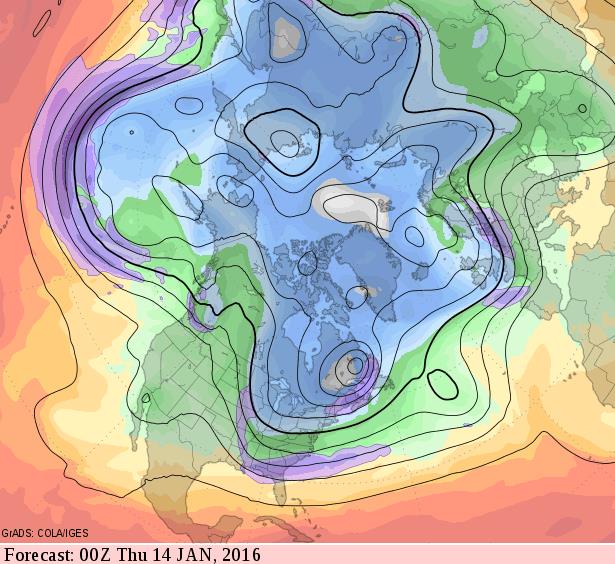
Colder by mid-January? Models are still flip-flopping, but at some point a negative AO (arctic oscillation) should allow much colder air to plow southward, especially east of the Mississippi River. Minnesota’s flow will still be tempered by Pacific air, taking the edge of some of the coldest temperatures by mid-month.
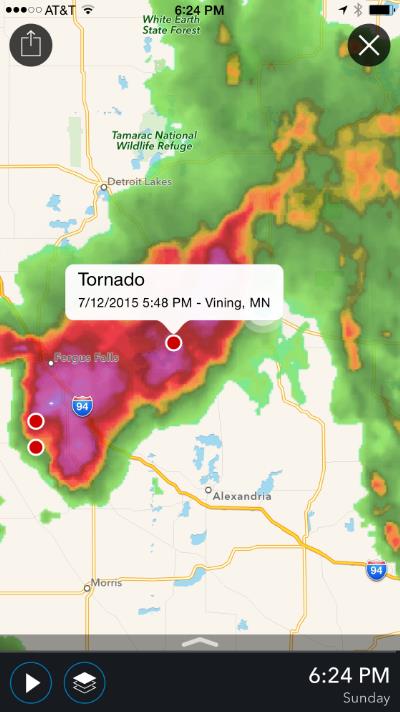
Top 5 Weather Events of 2015 in Minnesota. Thanks to Pete Boulay, the State Climate Office and the Minnesota DNR for passing this along; here’s an excerpt: “Here are the candidates for the top five weather events of 2015 from the Minnesota State Climatology Office. Please visit us on Facebook and post your top five weather events for Minnesota. Looking back over the past year there have been a few weather events that stand out against the rest. From the states second warmest Autumn ever, to smoke filled skies in July, this years top five events offer the weather variety Minnesotans are accustomed to.
#4 Straight Line Winds Wreck Havoc in the Brainerd Lakes Area: July 12, 2015
The most damaging severe storm event of the year came in the form of a line of severe thunderstorms that brought winds from 70 to 95 mph in an area just south of Wadena eastward to the Pillsbury State Forest where winds were in excess of 100mph in places. Significant damage was done to resorts on Gull and North Long Lake as well as the grandstand at the Brainerd International Raceway...”
Screenshot credit: Aeris Pulse.
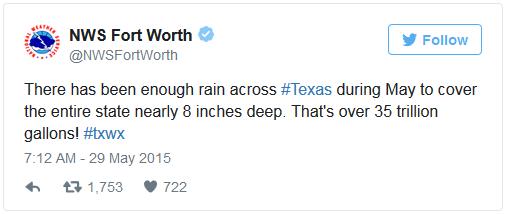
10 of the Wildest Weather Stories of 2015. You’ll remember many of these jaw-dropping moments, highlighted by Boston’s mega-snows and historic flooding across the Deep South; here’s an excerpt from wisc.com and Sinclair Broadcast Group: “…Texas and Oklahoma faced their wettest month on record in May 2015, with both states far exceeding their previous records for total rainfall. According to the National Weather Service, Texas was hit with enough rain to cover the entire state in 8 inches of water. The worst of the rainstorms around Memorial Day delivered fatal floods in Texas, Oklahoma, and Arkansas. Flooding earlier in the month caused an estimated $210 million in damage in Nebraska. In total, at least 40 deaths were blamed on southern flooding in May, according to the Weather Channel. President Obama declared a major disaster as storms bore down on Texas, causing evacuations, damage, and death...”

Why Forecasting Tornadoes is so Difficult. CNBC takes a look at the implications of the worst tornado death toll in December since 1953 in the United States, long before Doppler and split-second warnings: “…While there are some days that we know are going to produce storms … there are other days where conditions that are favorable for a tornado to form come together so briefly — for a few hours and over a very small area,” he said. “You really have to be incredibly diligent and never assume that it can’t happen today because conditions don’t look favorable. All it takes is one relatively small change in how the atmosphere is structured or how it is behaving, and that can make an incredible difference in the outcome.” That means that the National Weather Service often has little time to issue a proper warning — sometimes only a few minutes — before a storm hits…”
Photo credit above: “This aerial photo shows a damaged home after a tornado ripped through the area, Monday, Dec. 28, 2015 in Texas. Residents surveyed the destruction from deadly tornadoes in North Texas as the same storm system brought winter woes to the Midwest on Monday, amplifying flooding that’s blamed for more than a dozen deaths and prompting hundreds of flight cancellations. At least 11 people died and dozens were injured in the tornadoes that swept through the Dallas area Saturday and caused substantial damage.” (G.J. McCarthy/The Dallas Morning News via AP)
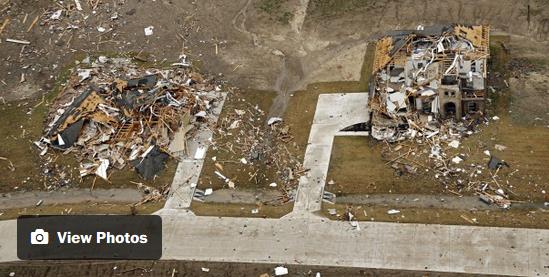
The Meteorology That Led to the Deadly Late-December Tornado Outbreaks. The Capital Weather Gang sets up the synoptic pattern that resulted in a swarm of tornadoes, including a rare December EF-4 near Dallas; here’s an excerpt: “…The synoptic weather chart from Dec. 26 shows the key atmospheric players. The strong Bermuda high parked over the Atlantic Ocean circulated warm, moist, unstable air northward, feeding into the warm sector of a surface low pressure system. Meanwhile, fast winds coursed along a pronounced dip in the jet stream, the trough, while sub-freezing air filtered southward into northern Texas. Some of the cold air aloft overlapped warm air at low levels in the cyclone’s warm sector, creating an explosively unstable atmosphere. The core of fast winds developed both directional turning and increase in speed with altitude (wind shear), an ideal configuration for supercell thunderstorms that spawn nearly all violent tornadoes…”
* Early estimates of tornado-related damage in Texas: $1.2 billion.
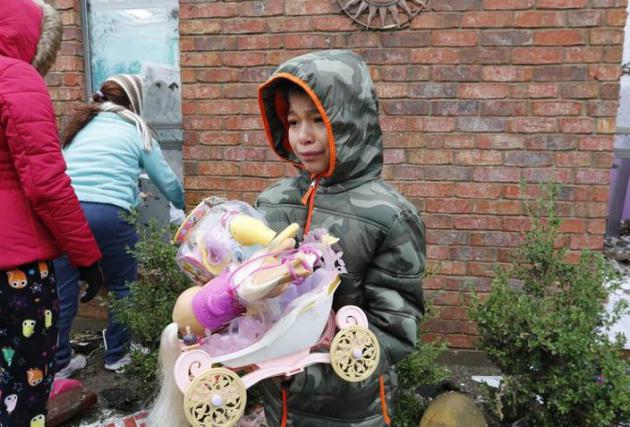
5 Tips for Helping Kids With Tornado Fears. Surviving a tornado brings on a weather-related form of PTSD, it really is a form of trauma and should be treated as such. Here’s an excerpt from The Dallas Morning News: “…Children of all ages may need and benefit from repeated reassurance. Although you can’t promise that tornadoes won’t return, you can reassure them that tornadoes are rare. Multiple conversations may be necessary, especially when children return to school and hear classmates say things that may need clarification. Maintaining typical schedules and routines can be comforting. Parents should stick to regular bedtimes, mealtimes and playtime. Preschool and elementary school age children might ask to sleep with parents. This is OK in the short term, with the understanding that it’s temporary until a set future date. For those directly affected by the tornadoes, parents should attempt to provide as much consistency and routine as possible at the shelters…”

Central Florida Tornado Outbreaks Possible With El Nino Patterns, Experts Urge Preparedness. Here’s an excerpt from The Orlando Sentinel: “…While the El Niño phenomenon lasts for about 18 months, the weather impacts are greatest over a 3- to 6-month window starting in December and lasting through spring, said Spratt, a warning coordination meteorologist for the NWS. During this time frame, the warmer oceanic temperatures cause a shift in the air currents that pass over the United States, delivering more turbulent weather to the Florida peninsula, Spratt said. “We want people to know that it’s going to be a dangerous time period this winter and into the spring,” he said…”
Image credit above: “Images show the three dealiest “tornadic thunderstorms” in Florida.” (Melbourne Weather Forecast Office).
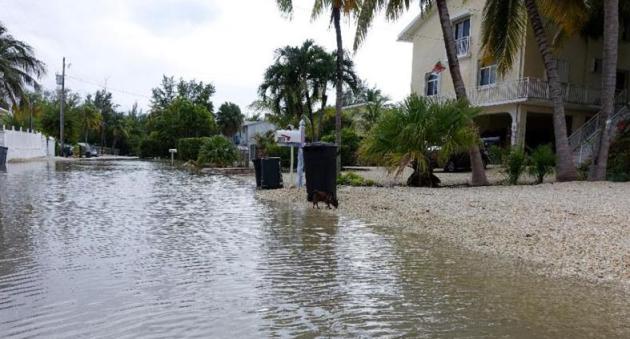
El Nino and Climate Change to Blame for Extreme Weather in Five Continents. Raw Story and AFP has an update; here’s an excerpt: “…This year’s El Nino is the most powerful ever measured, surpassing the one in 1997-98, both in terms of ocean surface temperature — up by more than 3C (5.4F) — and the surface area affected, said Lecou. As was true in 1998, this year’s super El Nino will have contributed to making 2015 the warmest on record, worldwide. But the reverse may also be true, with climate change boosting the power of cyclical El Nino events. “If you add the background global warming to natural weather phenomena, there’s a tendency to break records left and right,” Le Treut told AFP...”
Photo credit above: “Adams Drive in Key Largo, Florida has been flooded for nearly a month, after high tides were exacerbated by a super moon.” (AFP Photo/Kerry Sheridan).

Picture of Eastern Colorado Tornado Wins National Geographic Photo Contest. Here’s the intro to an explanation at NatGeo: “A picture of a tornado that touched down 50 miles northeast of Colorado Springs last summer has been chosen as the grand-prize winner of the 2015 National Geographic Photo Contest. The winning twister was one of as many as five tornadoes that touched down in the Simla area on June 4, damaging sheds, barns and outbuildings. The photograph was captured by James Smart of Melbourne, Australia. Smart took the award winning picture on the last day of a 15 day storm chasing tour...”
Photo credit above: Photo by James Smart / Provided by National Geographic.

Scientists Cleverly Use Cargo Ships for New Tsunami Warning System. Huffington Post reports; here’s an excerpt: “…By using GPS systems and satellite communications, the newly outfitted ships form a network of open ocean tide gauges. In the deep ocean, a tsunami wave may only be a few inches high. But with the additional data points, researchers will be able to generate more accurate predictions and models — and at a fraction of the price of a network of fixed sensors. “Our approach offers a new, cost-effective way of acquiring many more observations to augment the current detection networks,” co-investigator Todd Ericksen said in the statement…” (File photo: AP).
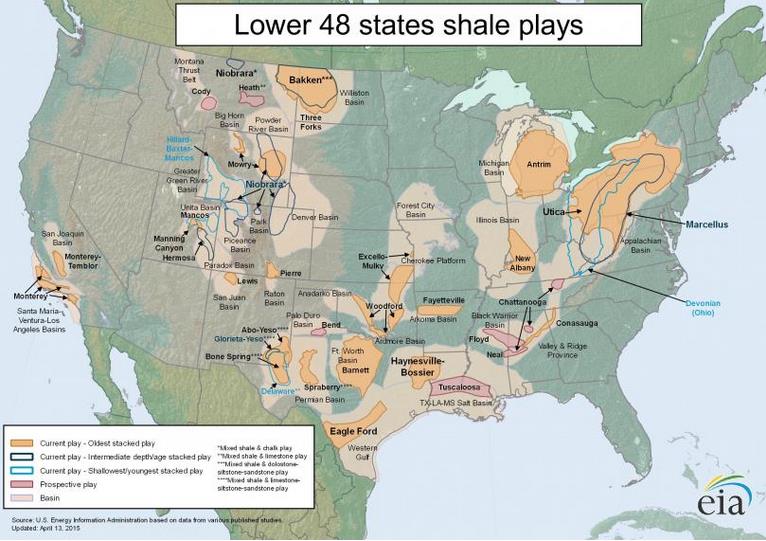
Winter Weather 2015: Severe Weather Disrupting U.S. Oil, Gas Production. Here’s a snippet from International Business Times that caught my eye: “…Natural gas prices have plunged due to the recent spell of unusually warm weather in the Eastern United States, which drove down demand for household heating. Several states recorded record high temperatures around Christmas, with temperatures reaching 72 degrees in New York City Dec. 24 and hitting 68 degrees in Burlington, Vermont, Dec. 25. Natural gas futures this month traded at the lowest levels since 1999, with gas closing at $1.79 per million British thermal units Dec. 15. Now, with forecasts showing warmer weather on the horizon in January, natural gas futures are surging. Futures for February rose more than 5 percent Tuesday to $2.372 per unit...”



NEW YEAR’S DAY: Cold start, not as harsh PM hours with some sun. Winds: SW 8-13. High: 28
SATURDAY: Sunny spells, chance of a thaw. Winds: W 8-13. Wake-up: 18. High; 33
SUNDAY: Blue sky, light winds, good travel. Winds: NW 5-10. Wake-up: 17. High: near 30
MONDAY: More clouds than sun. Wake-up: 18. High: 29
TUESDAY: Patchy clouds, few flurries possible. Wake-up: 19. High: 32
WEDNESDAY: Intervals of sun, still quiet. Wake-up: 17. High: near 30
Climate Stories…

U.S. Views on Climate Change Pose Test for 2016 Candidates. Financial Times explains the paradox: Americans are increasingly concerned, but wary if taking action imposes costs. If the GOP candidate denies the science swing voters may be turned off, if the Democratic nominee has a road map for action that is deemed too costly or “job-killing” there may be a similar backlash. Here’s an excerpt from Financial Times: “Barry Rabe, who has done extensive analysis of opinion polls, says: “All the evidence suggests there is growing concern about this issue, but limited evidence that that translates to any groundswell of support for any particular policy, especially one that imposes costs.” Mr Rabe, a public policy professor at the University of Michigan, says the lack of a “pivot” from concern to action has created a paradox, which the eventual 2016 nominees will have to navigate in November’s general election. The Republicans’ candidate cannot afford to alienate swing voters by appearing insufficiently worried; the Democratic nominee, expected to be Hillary Clinton, cannot risk turning them off with overly-aggressive solutions…”
Image credit: Voice of America.

Extreme Research Shows How Arctic Ice is Dwindling. Rapid warming of the arctic is having a domino effect on weather and lower latitudes; here’s an excerpt of a National Geographic update: “…Since 1979, when satellite records began, the Arctic has lost more than half its volume of ice, which has diminished in both overall area and thickness. The frozen area shrinks to its annual minimum in September, at summer’s end. In September 2012 its extent was just half the average during the 1980s and ’90s. The maximum ice extent in winter, usually reached in March, also is declining, though at a slower rate; its average thickness has decreased by half. What was once mostly a layer of 10- to 13-foot-thick ice floes that lingered for years—perennial ice—has given way to large tracts of thinner, less reflective ice that forms and melts during a single year. Sea-ice coverage has always fluctuated naturally, but there’s little doubt among scientists that man-made greenhouse gases are now accelerating its decline. “Old, thick sea ice was a global reservoir for cold, but that is now changing,” Overland says…”

How Climate Change Caused a Shift in Trends and Tech in 2015. Here’s the intro to a story at virgin.com: “The agreement was hard won, with country representatives working all night over the summit’s last weekend to get the nuts and bolts firmly in place. The deal means that countries promise to control the numbers of carbon emissions. Simply put, these are the amounts by which countries damage and pollute their atmosphere. Climate change has caused a change in trends and technology. Right through 2015, we’ve seen a desire by country leaders to work with entrepreneurs to help tackle the problem. Entrepreneurs have been examining this through their companies; Bill Gates, Mark Zuckerberg and Richard Branson have formed a group to invest in early stage clean energy companies...”

2015: The Year That Changed Everything? There was some good news, some hopeful developments in 2015; here’s an excerpt of a post at Cassandra’s Legacy: “…So, let me list some of the good things that happened in 2015. The Papal Encyclical on climate, the “Laudato si'”. This has really been something big. For one thing, it was clear from the way it affected the debate. Mostly, climate scientists, and scientists in general, are no-nonsense people, often atheists or agnostics, rarely churchgoers. So, the arrival of the Pope in the debate took them by surprise: “The Pope? What? Does he agree with us? Really? He said that God orders to us to safeguard the creation….. Eh….?” You can’t imagine how happy these solemn scientists were; like children receiving a Christmas gift in August! But the main effect of the Pope’s encyclical has been on the anti-science camp. They were, clearly, in difficulty...”

“…I think if we were truly confronted with the humanitarian consequences of climate change, only a tiny proportion of individual humans would accept the risk and suffering entailed by inaction. Yet, despite acknowledging the data on this, nations continue to squabble over negligible reductions in carbon emissions. Individual humans have the foresight and global perspective to appreciate that this is a disaster, but our organizations are structured to deny that perspective precisely because it undermines their success in short-term competition…”
– from a Quartz essay on the perils and promise of AI, available here.

Highlights of Climate Change Research in 2015. Greg Laden takes a look at some of the biggest headlines of the year related to climate science; here’s the intro: “The following is a list of posts on this blog that report new climate change research, usually but not always from the peer reviewed literature, or posts that are longer essays intended to give context to ongoing climate change research. The first few posts are from December 2014, which addresses the fact that “year end summaries” tend to be written during December, or even before, so December of any given year gets the shaft.
- December 2014 – How scientists unraveled the El Niño mystery
- December 2014 – New Research on Tree Rings as Indicators of Past Climate
- December 2014 – Global Temperature A Century Ago Vs. Today…”

2015 Review: Richard Muller “I Was Wrong on Climate Change”. Here’s an excerpt of a post and video from Peter Sinclair: “For those that don’t remember, Richard Muller is the UC Berkeley physicist, who became, briefly, a darling of climate denialdom, after saying a bunch of nasty things about climate scientists and their research. With money from the Koch Brothers, Muller formed a new research team, determined, he said, to get to the truth of the temp record. Funny thing, he confirmed what all those crazy climate scientists had been saying all along…”

2015 in Review: The Year Environmental and Climate Issues Left Their Silos. Here’s a clip from Environmental Health News: “...Scientists, too, are connecting more dots among different environmental topics. In July and November, Stanford University professor Paul Ehrlich and University of California, Berkeley, Professor John Harte published two pieces on food security and the intertwined nature of ecological and social systems. “An enormous number of conditions have to be met if humankind is to thrive sustainably,” Ehrlich and Harte wrote in the International Journal of Environmental Studies this summer. They added: “The basic dilemma facing humanity is how to solve enough of these problems, many if not most acting synergistically, to avoid a disastrous decline in general health, cognitive ability, and social order...” (File photo credit: Brian Weed, Shutterstock).

